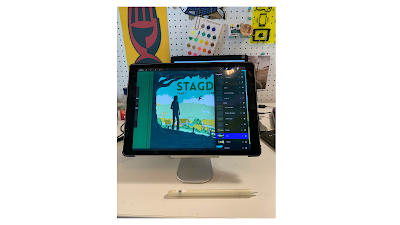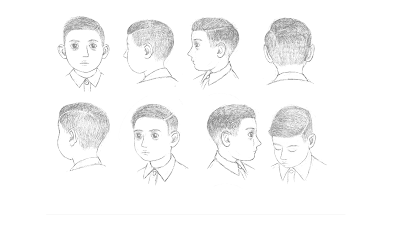During the 9th lecture of the series we looked at the work of Frances Castle. She took us through her journey in the creation of her opus Stagdale. Her dedication to research and graphic storytelling is at the heart of her process. It was a detailed lecture that showed clearly why illustration is a fabulous occupation.
Frances explained that having her own publishing company allowed her to promote her Graphic Novel series. Her story shows us how life repeats itself via flashbacks to the 1970's where we are introduced to the new world that our protagonist Kathy inhabits. This is followed by flashbacks to the 1930's where we are introduced Max and his ordeals during Kristallnacht and as part of the Kindertransport. Thanks to Frances for sharing her work with us over at the London College of Communication.
All work set out below is copyright of the Illustrator & Author, Frances Castle.
© Frances Castle 2022.
Frances has worked as successfully freelance illustrator for many years. This career follows on form her time working for games design companies. Frances is also a musician and publisher and it through her label Clay Pipe Music that she was able to publish her graphic novel series, Stagdale.
It's through her interest in family history and the historical significance of London that she began working in a narrative format that owes a lot to comics and storyboards.
With work of this kind in her portfolio it led to a major publisher became interested in her developing a project with them about two distinct time-periods that connect two very different children via the discovery of a dairy/ journal that was hidden in a house they had both lived in. The way that life repeats or mirrors itself. After the development of the concept period the project did not take root and wasn't progressed to the publication stage.
Frances felt the project still had potential so decided to continue to develop it for herself and to publish the outcomes through Clay Pipe Music. She changed the time period and gender of the boy (who was originally for the United states) to that of a girl and to set that time period in the mid 1970's. The German boy remained the same as this part of the story was already firmly established and researched. Frances uses a research technique that relies on selecting images that help her to craft/ weave her drawings into a believable story.
For Stagdale, Part 1 you can see her process above. Taking its lead from old photographs for reference, revised drawings and compositions. Colour testing and establishing and a consistent look for rural England in the mid 1970's. Every detail is examined and reflected upon to see if it fits her intentions for this story.
For Stagdale, Part 2 you can see her process above. Supporting the truth of a dark period in human history through the use old photographs for reference, revised drawings and compositions. Colour testing and establishing and consistent look for rural Berlin at the end of the 1930's. In Part 2 she shows the moral core of the narrative and takes us through the flashback into the heart of darkness. Again, every detail is examined and reflected upon to see if it fits her intentions for this story.
Stagdale, Parts 1 & 2 come with a limited edition Flexi disc that contains music that is evocative of the time periods that the graphic novels are set in.Stagdale, Parts 3 & 4 are on their way, check out Clay Pipe Music for further details.
References
Foster, K. (a) 'Stagdale Part 1', .
Foster, K. (b) 'Stagdale Part 2', .
Kaelberer, A.P. (2017) Kristallnacht. Raintree Uk.
Samuels, D., Greiffenhagen, I. and Leoprechting, B.v. (1993) Kindertransport. München: Pegler.













































































No comments:
Post a Comment